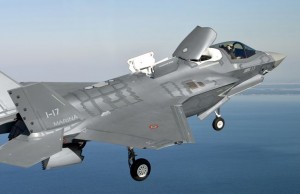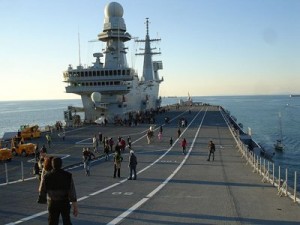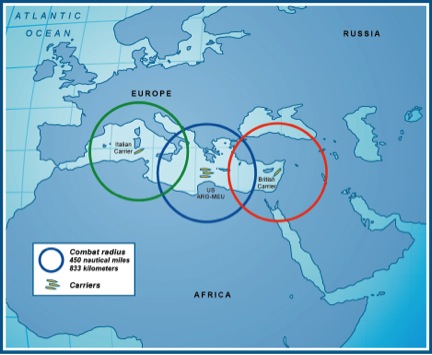2013-05-03 As Singapore gets closer to announcing its F-35B downselect decision, it is important to underscore the key role, which Italy has played in the program and in building a carrier on which the airplane will operate.
As the F-35 “club” expands, significant effects will come from the ability to work together.
As Ed Timperlake wrote at the time when the F-35B was on “probation:”
The F-35 is part of enabling a coalition of like-minded states and shaping a global fleet capability. Allies worldwide are building ships upon which the F-35B could land and operate. Yet the myopic IOC cost focus, forgets the capability issue and notably coalition capability. In a cost downturn, the US would wish to have less or more allies? The US would wish to have a globally enabled fleet of C4ISR D aircraft or stovepiped fleets located on specific US decks?
The F-35B “club” allows deployed ships to shape what General Hostage called a very flexible “air combat cloud” at hundreds of miles over the fleet. The F-35 operating as a fleet is the foundational point about the F-35; and the ability of the aircraft to exchange information seamlessly and to shape evolving combat capabilities over time.
The F-35 also has the capability to operate miles away from one another, but with a major difference. The individual airplanes are interconnected, operate in 360-degree operational space, and the machines pass the data throughout the network.

Each individual plane can see around itself for significant distances in 360 degree space, which has already underscored the need for a new generation of weapons, for systems such as AMRAAMs operate in half or less of the space which each F-35 can see beyond itself.
It is the interconnected C5ISR delivered by the fleet, coupled with the ability to work with the off-boarding of weapons which shapes a new way forward. Target acquisition does not have to be limited to weapons carried on board.
This means that classic distinctions between tactical fighters doing close air support or air superiority missions or air defense missions become blurred. The fleet as a whole identifies targets for the various mission sets and can guide weapons from any of its elements to a diversity of targets.
The reach of the fleet is the key to the operation of the fleet, not the range of individual aircraft.
In the graphic below, a notional intersection of F-35Bs operating off of an Italian carrier with that of the UK with that of the USN-USMC Amphibious Ready Group in the Mediterranean is represented:
The fleet operates by the machines within the plane trading data with one another so that the circles represent a common operating picture over the reach of the multiple flying assets. The COP provides a setting within which the pilots can operate to shape situational decision making appropriate to the mission.
And the circles are actually 360 degree situational awareness enabled operating areas. The reach throughout the Mediterranean simply from three ships operating their F-35Bs and delivering situational awareness, strike and situational decision-making is significant even without considering the other assets with which the fleet will interconnect with.
Italy’s contribution to the F-35 global fleet is greater than buying F-35As and Bs. Italy is as well opening their final assembly facility this year. The Italian FACO will be available not only for Italian aircraft but the partners as well. And can serve as a maintenance hub for the US and allied forces in Europe.
In an interview with two Lockheed managers involved in standing up the facility in Italy, they emphasized the following:
The plant was sized for 24 (aircraft) a year, including the Dutch aircraft. So, planning is underway for that. However, there is no official agreement in place yet between the Dutch and the Italians.
Question: And obviously such a facility could perform a key role for MCO in Europe and the region?
Answer: It clearly could. They are making a very strong play to be MRO go-to for that region. Given their investment, what they’re doing with the capability standup, it’s our position that that’s a logical choice.
However, that work has to be contracted, awarded and competed. But they are making a very, very strong case for that work to be put there in the future.
In discussions with senior USAF officials, it is clear that they understand the impact of having Italian maintenance facilities in place and the opportunity of providing for MRO services in the future for the USAF from this facility.
According to one senior USAF officer in Europe: “The FACO facility in Italy is best positioned to provide MRO&U for Europe-based F-35s well into the future.”

The Italian magazine, Rivista Italiana Difesa, has provided a further perspective on Italy and the F-35.
In a recent issue, the magazine provided an overview on the F-35 as seen by a senior Italian defense official. In a translation (by Second Line of Defense) from the original Italian of the key passages from the March 2013 interview, Debertolis, the Italian Secretary of Defense, discussed the F-35 and related defense issues.
RID: For Defence, the F-35 is crucial both for the operating capabilities it should guarantee to Air Force and Navy, and for the huge investment that the Defence itself put in the program. In light of this, are you concerned about delays and problems that the program already faced?
Gen.Debertolis: Currently, we aren’t worried about delays and we don’t expect anything to change. Such problems are common for a development program that, to date, completed only 35% of its test and evaluation schedule.
“Mitigation” activities are ongoing to face those problems. Only to give an example, in the STOVL version, some turbofan parts have been replaced due to excessive vibrations.
RID: Italy hasn’t formally expressed its commitment yet and the number of 90 is purely hypothetic. Can we make the point of the program status?
Gen.Debertolis: Italy will receive the first 3 aircraft in 2015. They’ll belong to Low Rate Production Lot 6, which has been already funded by Italy to sustain long term production activities.
Assembly operations of the first aircraft on the Electronic Mate and Alignment System (EMAS) will start in Cameri this year, on 18th July.
For what concerns the number of 90 fighters, we hope that it’ll remain unchanged – as the reduction from 131 to 90 already guaranteed a total saving of 4 billion euros.
RID: Regarding Cameri, which is the FACO capabilities in perspective?
Gen.Debertolis: Currently, Cameri plant has the authorization to produce Italian and Dutch aircraft. The Netherlands has ordered 85 aircraft which means producing 10 aircraft per year plus 11 aircraft for the Italian Air Force. Aircraft production for the Netherlands should start from LRIP 10/11.
That said, Lockheed Martin itself acknowledged that the FACO is a crucial asset of the program and, if required, even the production of other Countries’ aircraft could be hosted here (if producing 24 aircraft per year is in line with the capacity of the plant.
RID: Today the program is in the spotlight for the scarce industrial returns. Do you think that the future role of Italian industry could become more important?
Gen.Debertolis: We should consider that, when the program will be at regime, Cameri will become the European pole for maintenance and upgrade of the F-35 (MROU, Maintenance, Repair, Overhaul and Upgrade), treatment of the aircraft stealth surface included, with periodic upgrades every two years for software and every four years for structural parts.
It’s within this scenario that new opportunities could actually be growing for our industries. We hope that some limits could be removed in the future, such as the prohibition for non-US personnel to access the Aircraft Test Facility (ATF).
RID: Sure, a big help could come from the integration on the aircraft of European armaments?
Gen.Debertolis: Absolutely yes. The fact that we can integrate the F-35 with non-US armaments would allow us to enter the aircraft’s heart itself.
Regarding this, the UK has already started to study METEOR’s integration and asked us to create a joint program with this main purpose. We are evaluating this opportunity and, above all, its costs. It’s an important investment, around €100 million euros per country…..[ref]Translation by Second Line of Defense[/ref]
With the block four decision for software development of the F-35 to include the Meteor missile on the aircraft, the UK and Italian engagement with the F-35B club could lay a foundation for the other members as well. The Meteor also provides another advantage for the Italians who will operate both Eurofighters and F-35s.
The Meteor missile will be able to operate off of both platforms, providing a basis for anticipating the weapons carrying role for a very capable role for a non-stealth enabled aircraft in the years ahead.
As General Hostage, the ACC Commander, discussed the evolution of the interaction between 5th generation aircraft and older aircraft in shaping synergy in 21st century air operations:
The 5th generation aircraft will enable the air combat cloud and allow me to use my legacy assets differently. Many of my 4th generation fighters can be used to extend the network of linked systems, providing reinforcing fires, and I can focus on the 5th generation assets as the core nodes shaping distributed joint capabilities.
In short, Italy is a key part of the global development of the F-35 as a global fleet, both deployed, upgraded and sustained.
The F-35 is a key focal point of generating global investments in 21st century airpower, and Italy is a key player in this evolution and this effort.
For a look at the F-35 and partners see the following:
https://sldinfo.com/the-f-35-allies-and-global-investments-in-21st-century-airpower/
For a look at the weapons revolution, and MBDA see the following:
https://sldinfo.com/building-a-21st-century-weapon-the-case-of-the-meteor-missile/
Note: The Cavour is one of Italy’s two aircraft carriers and will host the F-35 JSF
Length: 735 ft
Commissioned: 2008
Carries: 20-30 aircraft, including the Harrier combat jet.
Crew: 451 crew, 203 airmen, 140 command staff and 325 Marines.
Propulsion System: 2 gas turbines, 6 diesel generators
History: Launched in 2004, the Cavour’s first mission was an aid mission to Haiti after the 2010 earthquake.
The Cavour will be eventually be stocked with the F-35B Joint Strike Fighter, replacing the aging Harriers. It has room for ten F-35Bs in the hanger and six on the deck.



